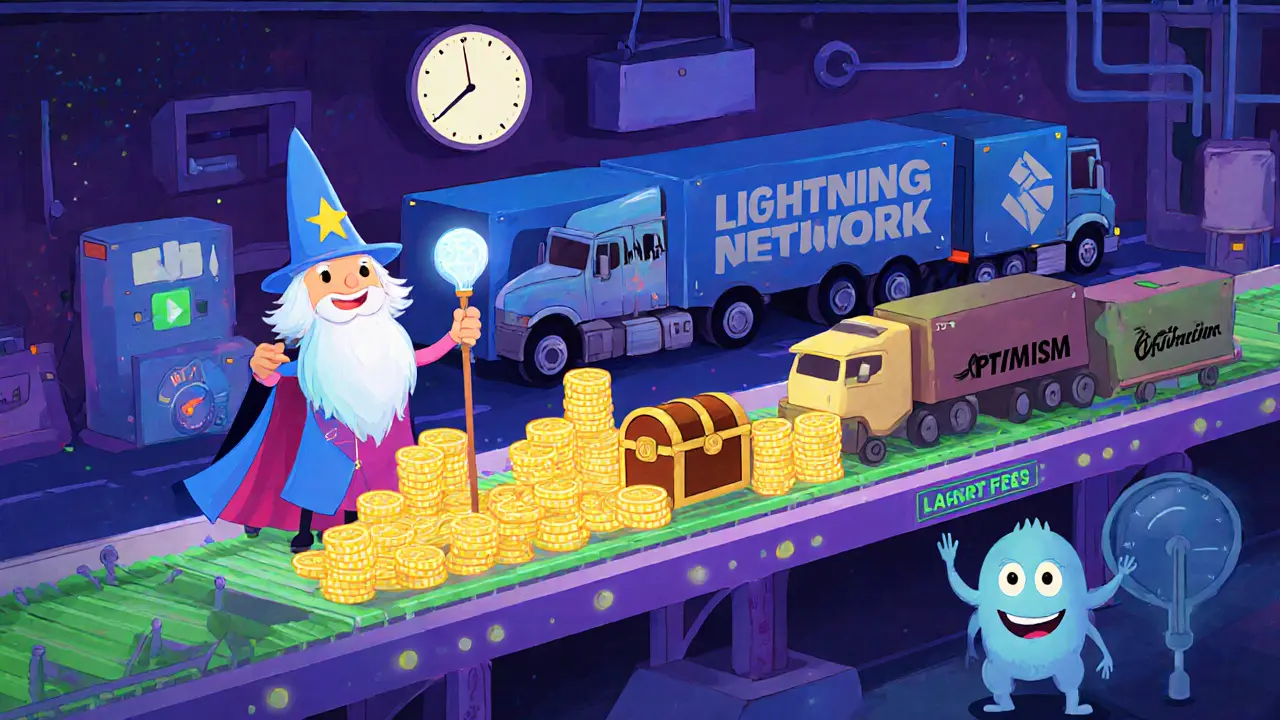Blockchain Fee Reduction Calculator
Potential Savings: $0.00 (0%)
Reduced Cost: $0.00
Breakdown of Savings
| Strategy | Estimated Impact | Savings Amount |
|---|---|---|
| Select options and click Calculate | ||
Paying too much to move crypto can kill any good deal. The good news? You don’t need to be a developer to keep blockchain transaction fees under control. Below are real‑world tactics that cut costs by up to 80%, whether you’re sending a few dollars or processing millions for a business.
Quick Takeaways
- Batch multiple payments into one transaction to share a single fee.
- Trade during off‑peak hours using gas trackers for optimal pricing.
- Leverage Layer2 networks like Lightning, Optimism, or Arbitrum for near‑zero fees.
- Use Replace‑by‑Fee (RBF) to bump stuck transactions instead of overpaying upfront.
- Choose fee‑optimised wallets or custodial services that auto‑adjust fees.
Understanding Why Fees Vary
Fees compensate the network’s validators or miners for securing the ledger. Three main forces drive the price:
- Network congestion: More pending transactions push prices up.
- Transaction complexity: Smart contracts and data storage need more computational work.
- Timing: Peak usage times-usually daytime in major markets-spike demand.
Because these factors fluctuate, a fee that seems reasonable at 9AM GMT could double by 3PM GMT. Knowing the levers lets you plan smarter.
Batching: One Fee, Many Payments
Imagine sending ten invoices separately. Each one incurs its own fee. With batching, you combine those ten payments into a single on‑chain transaction. The total fee stays roughly the same, but the cost per payment drops dramatically.
BitGo offers an institutional‑grade batching tool that groups up to 1,000 transfers into one Ethereum transaction. For a business moving $100,000 worth of USDC, BitGo’s analysis shows a 70% fee reduction compared with individual sends.
To batch yourself, look for wallets that support “multiple‑recipient” or “batch” modes. Many hardware wallets and software apps now include this feature.
Timing Your Transactions
Off‑peak windows-late night UTC, early mornings, or weekends-usually see lower demand. Tools like Etherscan Gas Tracker tracks real‑time Ethereum gas prices and predicts optimal fee windows let you set alerts. For Bitcoin, Mempool.space visualizes Bitcoin mempool congestion and suggests fee rates does the same.
In practice, a user who switches a $500 transfer from 2PM to 2AM UTC can shave off 30‑40% of the fee, according to a 2025 Klever.io guide.
Replace‑by‑Fee (RBF): Pay When You Need to
RBF lets you broadcast a low‑fee transaction first. If miners don’t pick it up within your desired window, you resend the same transaction with a higher fee. This way you avoid overpaying right away.
Most modern Bitcoin wallets-Electrum, Sparrow, and even mobile apps like BlueWallet-support RBF. Just enable the “opt‑in” toggle before sending.

Layer2 Scaling Solutions
Layer2 networks settle transactions off the main chain and only post summaries periodically. The result? Fees that are a fraction of a cent.
| Layer2 | Typical Fee per Tx | Settlement Speed | Best Use‑Case |
|---|---|---|---|
| Lightning Network Bitcoin Layer2 for instant micro‑payments | $0.0005 | Seconds | Retail, gaming |
| Optimism Ethereum Optimistic Rollup reducing gas costs | $0.001‑$0.005 | Minutes | DeFi, NFTs |
| Arbitrum Another Ethereum Optimistic Rollup with high throughput | $0.002 | Minutes | High‑frequency trading |
| Solana High‑speed native blockchain with sub‑cent fees | $0.007 | Seconds | Games, Web3 apps |
Adopting these solutions usually means setting up an on‑ramps bridge (e.g., depositing Bitcoin into a custodial Lightning wallet) and learning a new interface. The learning curve is a few days for individuals, but the savings can reach 90% for recurring payments.
Fee‑Optimised Wallets & Custodial Services
Some wallets give you a discount when you pay fees in their native token. Klever Wallet, for example, lets you pay swap fees with KLV, unlocking up to a 20% reduction.
On the institutional side, BitGo provides custom fee profiles, pre‑approval workflows, and intelligent bundling that automatically selects the cheapest route for each batch.
These services often include dashboards showing historic fee spend, so you can track savings over time.
Real‑World Case Studies
A mid‑size e‑commerce retailer processed $500,000 in sales annually. Using a traditional gateway (PayPal/Stripe) cost $35,000 in fees. Switching 60% of the checkout flow to crypto payments (USDC on Ethereum via a Layer2 bridge) slashed fees to $5,000, preserving $465,000 in revenue.
In cross‑border logistics, a firm moved $10million of supplier payments through Solana. They saved roughly $800,000 in conversion and transfer fees, cutting settlement time from three days to under a minute.
Step‑by‑Step Checklist for Reducing Fees
- Identify the blockchain you’re using (Bitcoin, Ethereum, Solana, etc.).
- Check if your wallet supports transaction batching; enable it.
- Monitor fee trackers (Etherscan, Mempool.space) and note off‑peak windows.
- Choose a Layer2 solution that fits your use‑case (Lightning for micro‑payments, Optimism for DeFi).
- If you need a Bitcoin transaction, enable RBF before sending.
- Consider paying fees with the network’s native token if a discount exists.
- For businesses, evaluate custodial platforms like BitGo for automated fee optimisation.
- Review monthly fee reports to verify savings and adjust strategy.
Common Pitfalls and How to Avoid Them
Don’t chase the lowest fee at the expense of security. Some ultra‑cheap Layer2 bridges have experienced hacks; stick to audited projects.
Beware of “fee‑grabbing” exchanges that quote a low network fee but add hidden spreads on conversions.
When batching, ensure the total transaction size stays under the block limit; otherwise the network may reject it, costing you a failed‑tx fee.
Future Outlook: Fees Keep Dropping
Ethereum’s road‑map (EIP‑1559, Pectra) stabilises gas, while upcoming sharding solutions promise even lower costs. Stablecoins like USDC continue to dominate fast, cheap cross‑border payments, eliminating currency‑conversion spreads entirely.
Experts from Deloitte predict a 12.5% reduction in corporate cross‑border costs by 2030, equating to $50billion in savings globally. The trend is clear: as more businesses adopt layer‑2 and batching techniques, the average fee per transaction will keep sliding toward pennies.

Frequently Asked Questions
Can I batch transactions on any blockchain?
Batching is natively supported on Ethereum and Bitcoin via specialized wallets. Solana allows multi‑transfer instructions, while other chains may need custom scripts or custodial services.
What’s the safest Layer2 for everyday payments?
Lightning Network for Bitcoin and Optimism for Ethereum have the strongest audit histories and largest user bases. Stick to well‑known custodial bridges if you’re new to the tech.
How does Replace‑by‑Fee actually work?
You broadcast a low‑fee transaction marked as replaceable. If it lingers in the mempool, you resend the same transaction with a higher fee. Miners pick the latest version, and you only pay the final fee.
Do fee‑discount tokens like KLV affect transaction speed?
No. The discount only reduces the amount you pay; the underlying network speed remains unchanged.
Is it worth paying a service fee for automated batch processing?
Typically yes for businesses processing dozens or hundreds of daily payouts. The service fee (often <0.1% of transaction value) is far lower than the cumulative on‑chain fees you’d otherwise incur.


Courtney Winq-Microblading
May 24, 2025 AT 00:35When you stare at a blockchain fee chart, you’re really looking at a living ecosystem that breathes with market sentiment. Every surge in gas price is a reminder that the network is a crowded highway, and you’re just another driver seeking the fastest lane. By batching payments you turn that highway into a convoy, sharing the toll among many passengers instead of paying solo. Think of it as ordering a pizza for the whole office rather than buying one slice per person; the delivery fee stays the same but the cost per slice drops dramatically. Off‑peak timing works like catching the night train when the stations are empty; the tracks are clear and the price drops to a whisper. Tools like Etherscan’s gas tracker let you set an alarm for those quiet windows, so you never overpay in the rush hour. Layer‑2 solutions are the secret shortcuts under the city, letting you zip past the congestion for pennies. Lightning, Optimism, and Arbitrum each have their own entry gates, but once you’re inside the traffic disappears. Replace‑by‑Fee is the safety net that lets you start cheap and only bump the price if the network refuses to move your parcel. Most modern wallets hide this feature behind a simple toggle, making it as easy as flipping a switch. Fee‑optimised wallets that accept native tokens for discounts are like loyalty cards that shave a few bucks off every purchase. BitGo’s institutional bundling does the heavy lifting for businesses, automatically merging dozens of payouts into a single chain transaction. The only downside is the learning curve, but a weekend of tinkering beats paying a 30‑percent premium forever. In practice, a modest e‑commerce shop can shave thousands of dollars a year just by moving to a Layer‑2 bridge for routine withdrawals. So the formula is simple: batch, time, layer‑2, then fine‑tune with RBF and fee‑discount wallets, and you’ll watch those fees evaporate.
katie littlewood
May 27, 2025 AT 11:55Batching isn’t just a trick for big firms; even a freelance creator can bundle a week’s worth of payouts into one transaction and watch the fee shrink to a fraction of what it would have been. By grouping payments you essentially turn dozens of tiny gas burns into a single, more efficient burn, which the network rewards with lower overall cost. The key is using wallets that expose a ‘multiple‑recipient’ mode-most popular mobile apps have added this feature in the last year. Once you enable it, the process becomes as easy as selecting a few checkboxes and hitting send. It’s a small habit that adds up, especially when you’re moving stablecoins where the fee can easily outweigh the transfer amount. Give it a try on your next payroll cycle and you’ll see the difference instantly.
Jenae Lawler
May 30, 2025 AT 23:15While the enthusiasm for fee‑cutting tools is palpable, one must remember that transaction fees are the lifeblood that sustains network security. Without adequate remuneration, miners and validators would lack incentive to maintain the ledger, potentially jeopardising decentralisation. Therefore, the notion that one should always chase the lowest possible fee is, in my view, a naïve oversimplification of a complex economic model.
Chad Fraser
June 3, 2025 AT 10:35Hey folks, if you’re still paying full price on every send, you’re leaving money on the table-big time! Grab a wallet that supports batch mode and start grouping those payouts tomorrow. Keep an eye on gas trackers; the off‑peak windows are like secret sales you don’t want to miss. And don’t forget to dip into a Layer‑2 bridge; the fees there are practically laughably low. Turn these habits into a routine, and you’ll see your transaction costs plummet.
Jayne McCann
June 6, 2025 AT 21:55Batching works even on Solana.
Prince Chaudhary
June 10, 2025 AT 09:15Activating batch mode in your wallet can be as simple as toggling a setting, and the savings compound quickly when you consistently apply it across your regular transactions.
Sidharth Praveen
June 13, 2025 AT 20:35For those who prefer a quieter approach, scheduling transactions during the early UTC hours can shave a solid 30 % off the gas fee, especially on Ethereum’s busy days.
Jan B.
June 17, 2025 AT 07:55Fee‑optimised wallets often allow paying with the network’s native token for a discount. This can cut costs by up to twenty percent.
MARLIN RIVERA
June 20, 2025 AT 19:15That “discount” is just a marketing gimmick; the underlying fee structure remains unchanged and you’re still subsidising the network.
Debby Haime
June 24, 2025 AT 06:35Layer‑2 solutions are not a magic bullet, but they dramatically lower the per‑transaction cost when used correctly. Start by bridging a modest amount of stablecoins and test the withdrawal flow. Once you’re comfortable, scale up to larger batches for even better economies of scale. Remember to monitor the bridge’s security reputation before committing big sums. Combining these steps with regular fee‑tracking will keep your expenses in check.
emmanuel omari
June 27, 2025 AT 17:55The bridge’s security can be quantified by looking at audit reports and the number of successful audits completed in the past year; a higher audit count correlates with lower risk exposure.
Andy Cox
July 1, 2025 AT 05:15Different regions experience varied network congestion patterns, so aligning your transaction timing with local off‑peak periods can yield hidden savings you might otherwise overlook.
Richard Herman
July 4, 2025 AT 16:35Indeed, aligning with regional lull periods, especially on weekends, often reduces gas prices by a noticeable margin without sacrificing speed.
Parker Dixon
July 8, 2025 AT 03:55When you combine batch processing, off‑peak timing, and a reliable Layer‑2 like Optimism, the fee can drop to less than a cent per transaction 😊. This strategy is especially effective for recurring payouts such as subscription services. By automating the schedule, you avoid manual timing errors and keep the process smooth. The net result is a predictable, ultra‑low cost structure that scales with your business growth.
Stefano Benny
July 11, 2025 AT 15:15Leveraging rollup architecture abstracts transaction execution to a calldata‑centric model, thereby reducing on‑chain gas consumption to a minimal footprint.
Bobby Ferew
July 15, 2025 AT 02:35The emotional fatigue of watching fees eat into profit margins can feel like a silent thief, draining resources before they even reach the intended recipient. By adopting systematic fee‑reduction practices, you reclaim that lost value and empower your financial flow. It’s a subtle victory that builds confidence over time.
celester Johnson
July 18, 2025 AT 13:55While practical, such measures still ignore the broader systemic inefficiencies that stem from protocol design choices.
John Kinh
July 22, 2025 AT 01:15Fee‑optimisation is essential for anyone handling crypto at scale.
Mark Camden
July 25, 2025 AT 12:35From an ethical standpoint, pursuing lower fees aligns with the principle of maximizing net value for stakeholders, provided that the methods employed do not compromise security or regulatory compliance.
Evie View
July 28, 2025 AT 23:55Paying excessive fees is a form of financial self‑sabotage that many overlook in their haste. By deliberately scheduling transactions during low‑demand periods, you harness the market’s natural ebb and flow. This simple discipline can translate into substantial annual savings.
Sophie Sturdevant
August 1, 2025 AT 11:15Implementing automated batch scripts in conjunction with fee‑optimised wallets can streamline the process, ensuring that every payout hits the optimal cost window without manual intervention.
Nathan Blades
August 4, 2025 AT 22:35Think of the blockchain as a bustling marketplace where every vendor pays a stall fee; the smarter you are about when and how you set up your stall, the less you pay. Batching payments merges multiple stalls into one, slashing the collective fee. Timing your arrival during quiet hours avoids the premium surge. Layer‑2 bridges act like back‑alley shortcuts, bypassing the main thoroughfare entirely. Replace‑by‑Fee gives you a fallback plan if the market suddenly spikes. Together, these tactics form a robust playbook for fee reduction.
Somesh Nikam
August 8, 2025 AT 09:55For developers new to these concepts, starting with a simple script that groups daily payouts and routes them through a trusted Optimism bridge can provide a hands‑on learning curve while delivering immediate cost benefits.